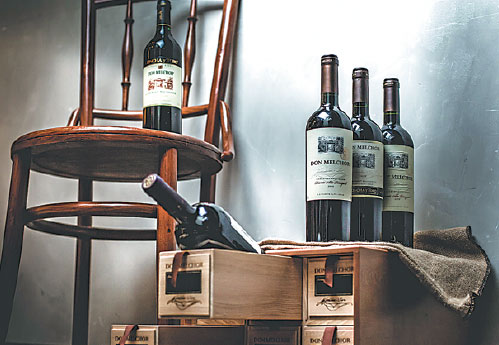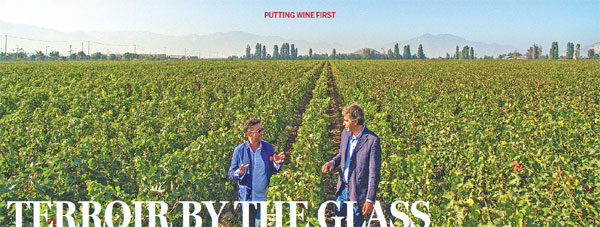Terroir by the glass
One of Chile's ultra-premium winemakers is touring Asia with a star chef, and standing the traditional wine-dinner concept on its head
Few people would have the nerve to ask a former three-star Michelin chef to eat dirt.
But that's more or less what Don Melchor winemaker Enrique Tirado did when he began to plan his current wine and gastronomy tour with celebrity chef Bruno Menard.
"At most wine dinners, you have a menu to start with and you go looking for wines that will complement those dishes," the oenologist tells China Daily in Beijing. "We are doing the opposite - we are starting with four vintages, and creating dishes with simple yet exquisite ingredients to enhance the key aroma and spirit of each Don Melchor vintage."
So before asking Menard to construct a menu to complement the four chosen wines, Tirado brought his consulting chef down to the southern end of the world to deconstruct the vineyard's profile. That meant all but inhaling the stony soils that produce some of Chile's top wines.
The Don Melchor story began in 1986, when leading Chilean winery Concha y Toro set out to create not only the finest red wine the Andean country could produce, but also create a "terroir wine" comparable to the elite wines of both the old and new worlds.
Geography matters
You would not expect a professional in a prominent agricultural business to get excited about "really poor soil". However, Tirado's eyes light up when he speaks of the alluvial but rocky material in which his prized vines are planted.
"The combination of stony soil and very little rainfall means that the roots go deep," he says of the cabernet sauvignon plants, now three decades old and well-established.
Other geographic factors have helped produced wines like the 2012 vintage, the company's "crown jewel" that won a 98-point rating from critic James Suckling and was named the year's best wine of Chile by Wine Spectator magazine.
The company's Puente Alto vineyard sits at the foot of the Andes on the Maipo River, where the grapes enjoy warm days but cool nights. Most of the year's rainfall comes in winter, not in late summer when it could spoil the harvest. The soil's high mineral content from clay, gravel and stones give the resulting wines a distinctive and consistent character. The nutrient-poor soil swept down from the Andes by the river is weakly absorbent, a combination that naturally limits both excessive leaf grown and fruit production.
The result is fewer but much better grapes.
While Tirado eagerly embraces modern technology as a tool, "it is observing and feeling each plant and wine that enables me to reach the perfect balance year after year." So while lab reports track the sugar levels, pH and other indicators as the fruits ripen, at harvest time he's out in the vineyard chewing on grapes and seeds every day, row by row.
"If you can taste a green note in the vineyard," he says, "you will get a green wine. That's very clear."
A major "secret" behind his wine's quality, says Tirado, is in the blending. Although the vineyard's 127 hectares are contiguous, the land is divided into seven distinct blocks and more than 100 parcels, each producing grapes that will deliver variations in aroma and taste as the wine is made. About 150 batches are tasted over several days each year; seven will be chosen for the final blend.
Marrying food and wine
By bringing Menard, who once ran the three-star Michelin restaurant L'Osier in Tokyo, to Chile to absorb the basis and the blending of the wines, the chef was able to develop a French menu with Asian elements to take on tour. While the menu has been the same from Tokyo to Seoul to Taipei to Beijing to Chengdu, the chef has looked to local farms to assemble his ingredients - always a challenge in new venues.
Menard, who joined the Lifetime channel's MasterChef Asia show as one of three judges in 2015, finds that kind of challenge very stimulating.
"A traditional wine dinner starts with a sparking wine, then maybe goes to a sauvignon blanc, then a more full-bodied white like a chardonnay, before finally getting to the reds," he says. "This dinner is all about cabernet sauvignon - it's very different to be drinking red wines from start to finish."
The opening vintage was the youngest of the night, the 2013. It's the most recent arrival on the market, 91 percent cabernet sauvignon and 9 percent cabernet franc. "That was the coolest year in the history of Don Melchor," says Tirado, and the wine is smooth with a lot of red fruit and a long finish." For that, Menard created a geranium-essence scented beetroot tartare with cacao vinegar and seasonal herbs.
Next came the oldest wine on the table, Don Melchor 1988. Menard married that richness with a combination of smoked eel and pan-fried foie gras, served on a French black-truffle flavored risotto made with buckwheat and a bit of perilla.
The third course was built around the 2005 vintage, a warm year that produced a softer wine and the first year the winemakers included cabernet franc in the cabernet sauvignon blend (3 percent). "The first aroma is sweet," says Tirado, "and then comes freshness, energy, and a long finish with refined tannins." Menard responded with duck, roasted at 39 C for one hour with a white miso and orange-marmalade glaze.
The final wine, from 2010, was ranked No 9 on Wine Spectator's Top 100 list that year. Also with 3 percent cabernet franc, it is a wine of many layers, and it was served with Menard's similarly layered made-for-the-occasion dessert: griotte and cabernet sauvignon "granite", griotte confit, chocolate biscuit with licorice and five-spice Chantilly.
"For me, wine-drinking is about experience as well as taste," says Rodrigo Jackson, Concha y Toro's managing director for China. "When I drink a particular vintage, I like to think back about that time, and what I was doing then.
"In 1988, for example," he says, "I was watching the Seoul Olympics, completely fascinated. And in Chile - we still had Pinochet then. Incredible times."
Eyes on China
Like every other wine producer, Chile pays a lot of attention to the Chinese market these days. While the government's 2012 crackdown on extravagance put a big dent in luxury purchases like ultra-premium wines, the team at Don Melchor sees a silver lining.
"People now are more likely to be buying wines that they like to drink themselves, instead of wines that will impress clients or make fancy gifts," says Jackson. "That means the market is becoming younger but more discerning, and much more sustainable long-term."
Globally, there is a rising trend in white wine sales, but that movement is more muted in China.
"In this country, grape wine means red wine," says Tirado, who has seen Don Melchor appear in more and more five-star hotels and top restaurants in China on his visits during the past two years.
"Making great red wine is what we're all about."
|
Vintages as old as 1988 have been featured in the company's ongoing Asia tour. Photos Provided To China Daily |
|
Winemaker Erique Tirado (right) brought celebrity chef Bruno Menard to Chile to plan a menu around his Don Melchor wines. Photos Provided To China Daily |
(China Daily 09/17/2016 page6)
















